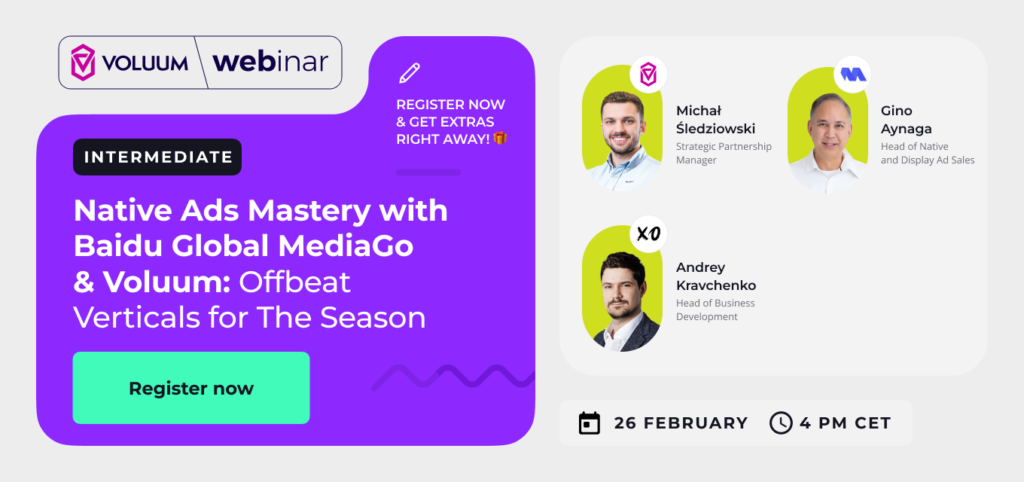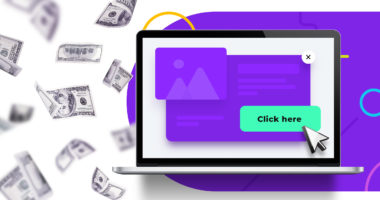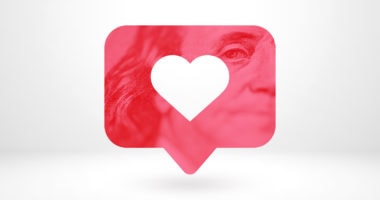Running a successful native campaign requires a great deal of preparation and planning. You need to find the right offer at the right time, you need to analyze your potential audience to aim your ads at, choose and test numerous native traffic sources select those that bring conversions, and don’t forget to allocate a working budget for tests and real-time running.
The work doesn’t stop here, however. Because now comes the part that shouldn’t be neglected at any cost – content preparation. We can’t stress enough how important it is to make your native ads stand out in this era of banner blindness. You have just a few seconds to be noticed and if you don’t grab the attention of your audience you’ll lose. Simple as that.
What is native advertising?
Let’s quickly remind ourselves that native advertising is a type of ad that tries to blend in with the website or feed they appear on. Native ads don’t look like traditional ads: they are not invasive and create an impression of being native to the content of the website.
Native ads have more visual elements – headlines and creatives – that work in your favor if you know how to master them. So how to make your headlines and creatives powerful and truly engage your potential clients?
We will start with headlines first and brief you on the most useful tips that work like a charm.
How to write a killer headline for your native ad
First of all, we can’t stress enough the importance of good copy. S don’t cut corners and make sure you put the effort in to really master the craft – or hire a professional. And, yes, headlines are the most important elements of them all. After all, if it doesn’t capture your readers’ attention – what will?
So, here are some native advertising headline examples that prove to work wonders.
1. Keep it short
I guess everybody has heard a thousand times already that the average attention span has been decreasing dramatically these past years. It means you need to make your headlines short and on point. Of course, different native traffic sources require a different number of characters, but the shorter you keep them the better.
But don’t take this rule too literally: of course you need to use the right headlines length to convey information properly. Just try to convince your readers why they need to click your ads in a captivating but brief and concise manner. Show what benefit you can give them, use catchy but useful headlines. Consider your headline as a preview of what your content will be about by also giving the “solved problem” your readers are searching for.
Discover the greatest secret in history.
2. Sense of urgency
Nobody wants to miss out on a bargain. This is how our consumerism-centric brain works in today’s consumerist world. Create an impression of urgency and scarcity with your message. You snooze, you lose!
Countdown begins for the biggest sale of the year.
3. Questions = curiosity
You can also use an interesting phenomenon known as the curiosity gap. It’s when our brain gets a sense of deprivation from realizing it doesn’t know something. You can trigger this feeling by providing a bit of information leaving the brain curious to find out more details on this matter. It works best with question-type headlines. A good tip here is to try to make your headlines relatable to people’s needs. Also, don’t write questions people could simply answer “no” to.
How much should your health insurance actually cost?
4. Offer a solution to the problem + use “How to”
Start your headline with a ‘How to’ phrase and promise to bring good results. It works almost every time! Why is it so good? Well, it’s simple. People want to know as many life hacks, shortcuts, and band-aid solutions in their lives as possible.
How to boost your productivity with these two simple tricks.
5. Use numbers
A recent study has proven that 83% of people find articles that have number references more reliable.
Well, I actually made that number up just to prove that sentences that contain numbers sound more convincing. And numbers are easier to notice in the flood of text.
How 8 out of 10 people lost 10 kg in just a few months.
6. Surprise your reader: use power words
People are prone to look for something new and exciting. That’s why it activates their anticipation for new experiences every time they see something unusual or unique.
Use curiosity-stimulating words such as “secret”, “unbelievable”, “surprise”. Also, don’t be shy and activate your inner best sales manager with power words such as ”awesome”, “super easy”, ”mind-blowing” etc. And yes, they do the trick.
One tip: in order to maximize your native advertising headlines, add these power words to your ad copy as well.
How she got this unbelievable result without any exercise!
7. Tell a story
Remember, I mentioned that you need to relate to people’s experiences? That’s exactly what telling a story can help you with. Tell something that people can relate to or associate themselves with. People constantly search for any confirmation that other people experience issues similar to theirs and that there is a solution to their current drama.
Adding appeal to emotion is also a powerful way to win the audience’s favour. It is intended to draw inward feelings such as common understanding, pity, joy and inclusion. Coupled with an intriguing narrative you can achieve outstanding results.
I tried a keto diet and here’s what I learnt.
8. Use listicles: top, best of
We all like lists. They organize information in a more digestible way and let us grasp a lot of information with minimum effort. Such native advertising headlines prove to be straight to the point and drive curiosity inviting users to click, and thus engage them in wanting to know more.
Also, listicles use such phenomena as confirmation bias. It’s when we search, interpret and favor information in a way that confirms or supports our own beliefs or experience. So when we find something in such lists that we expected to see, it’s like a pet on our shoulder: we confirm to ourselves that we are smart. That’s why they are so effective and so addictive.
Top 10 gadgets worth investing in.
9. Don’t be afraid of using negatives
Well yes, people also tend to be quite negative. Why else do you think the majority of news is always about something bad happening? That attracts attention, that’s why. And attention is exactly what we need.
Using words like “don’t,” “stop,” and “avoid” often works well because we all want to know if whatever it is we’re doing right now is actually wrong.
Avoid these 2 exercises if you want to have ripped abs.
10. Check your grammar
I mean it! Maybe you think nobody cares, but the truth is almost all of us have this nasty little grammar snob inside, ready to jump on the tiniest mistake someone else made. Should I mention that some native traffic sources treat this super seriously as well? You might have a mindblowing native ad but nobody will see it because a traffic source will reject your campaign due to spelling or grammar mistakes.
One more thing! Different native traffic sources can require a different number of characters. If you exceed this limit your campaigns will not even start bidding. For example, different native programmatic DSPs make their clients’ lives easier by giving direct information on how many characters you can have for this or that ad exchange.
11. Test variations of copy
Testing copy is an important part of successful marketing. Some marketing professionals will start testing and gathering audience feedback even before launching a campaign. Creating a catchy headline that basically becomes the foundation of your offer’s enchanting story is what’s going to build a lasting relationship with your clients.
So you always have to keep an eye on your results and make sure you provide copy that best targets your audience. To keep track of these tests and variations, make sure to use a reliable software designed for this, like Voluum.
You can also keep adjusting your copy as you go and use A/B testing to determine which copy resonates with your audience better and by doing that copywriting will become your best strategy of transforming your products to must-haves. So don’t be afraid to change things up and change your copy when you know it’s not working.
Earn Your Mac ’n’ Cheese Tonight
Is far more engaging and eye-catching for a gym than
We’ll help you slim down fast.
Good, the headlines are all set for now. It’s time to switch to something that is even more fun!
Additional general tip: use AI content generation!
If you are an experienced marketer, you do all these things mentioned above instinctively. If not, you can get AI to help you write quality headline and tell it how to do it properly.
You see, in many cases generative AI is only as good as commands (or ‘prompts’) it gets. To make it produce creative and fitting headlines, you need to tell it some more information rather than just prompting ‘Write cool headline please’.
How to write AI prompts
There are several rules that govern how to inform AI more accurately about what it should produce:
- Define a role. The most important thing is to define AI’s role. You can tell AI to act as a digital marketer or content writer – it will set the tone immediately.
- Define a reader. Another important thing is to tell the AI engine who its target readers will be. It will also try to match the language of the expected audience.
- Define a style. You can tell the language model if those headlines should be funny or informative, in the form of a question or not, engaging, or neutral.
- Outline minimum or maximum number of characters. This will put restrictions on the output material.
- Give examples. The easily forgotten way to make sure AI produces relevant output is to give an example. Include your own or someone else’s headline that worked and tell the AI engine to use it as a reference.
AI headline generators
Large language models can not only write you the content of the page but also the title (headline) for your ad. With such a short piece of text, AI can provide you with multiple propositions. Use prompts to instruct AI on the length of the headline, form (statement or questions), tone (light-hearted, informative, provoking), and keyword.
How to choose the best images for your native campaigns
By now you should know why it is important to dedicate some time to creating powerful easy-to-read headlines. So it’s time to focus on another part of content preparation. I’d say this one is even more creative and interesting. I mean, of course, the images that you will choose for your native campaigns.
After all, native advertising is all about attracting potential clients with intriguing and captivating images that will make them click. In order to get clicks we need to be sure the audience is interested in what you are about to offer.
So how to make your native creatives bring more and more clients? Here are a few tips!
1. Quality and correct size
Always aim for the best quality possible. It should be obvious and yet I still encounter native images that look really bad, e.g. with low resolution or strangely cropped. Which leads to another tip: always comply with the sizes required by a native traffic source of your choice.
Many native programmatic DSPs quite often crop your images automatically to match ad exchange’s size requirements. Sounds like a good thing, right? Wrong! If you didn’t pay enough attention you can be left with something weird or just plain ridiculous. Long story short – always double-check your image size and how it matches your traffic source’s requirements.
2. Choose a photo Opt for a real photo Choose a real photo over an illustration
Authentic and creative content resonates better with native advertising consumers. Just don’t go too overboard. For example, it’s better to choose real-life photos rather than illustrations. Realistic images prove to bring higher CTR.
3. Back to black
Opting for black and white images also shows better CTR compared to color ones. But it’s not set in stone. It doesn’t mean that you should upload black and white images and forget about them. Always keep color pictures for A/B testing and adjust your creatives when you see a drop in CTR.
P.S. Always run those A/B tests whenever you’re not sure about any element of your campaign. That’s like the digital marketing rule of thumb.
4. Humans and animals
Studies show that consumers tend to react better to the images with a human in them. It is due to the fact that we associate with a person and their experience rather than with some random objects.
Try to show genuine emotions on people’s faces. Every element of the image can reveal some precious information about the product or service you are promoting. So you want to make sure people you choose to show as a part of your campaign convey the right emotion.
Another example of a well-performing creative for native ads would be pictures featuring animals. They can provide you with a good CTR boost as well. I think there’s no need to explain why.
5. “No” to a text, “yes” to a close-up
Images without text perform better. So get rid of those captions and use your writing skills to create a compelling native headline instead (+ link to a previous article here).
Also note that close-ups work better. Especially when you promote a certain product – just focus on the product itself!
6. What do you promote?
Following tips on how to create great images is great and all, but don’t let all those suggestions and ideas to turn your focus away from your major goal.Your images should correlate to what you are promoting! Stay true to your content, product, and brand.
7. Change your creatives regularly
A lot of marketers overlook this tip completely. First, to make your creatives work, you need to experiment a lot. Don’t be afraid to try different angles and ideas. Once you find this perfect combination – rejoice! But not for long.
Don’t sit tight on your success. Keep in mind that native creatives have a tendency of getting worn out quite rapidly. Think about it: will seeing the same image over and over again make you any more interested in the product it offers? To repeatedly grab the audience’s attention the content should be regularly updated.
8. A/B Testing
Let me also separately remind you of the importance of testing. It’s one of the keys to your success too. You can follow every single step of a guide and a course, create killer headlines and creatives according to best practices but you’ll notice that some ad sets perform better than the others. That’s because you need to concentrate on the interests and demands of your target audience. And how to understand what your audience really needs? Correct! Give them a choice.
Nothing will make a bigger impact than changing a headline or changing a creative in terms of actually increasing engagement rate. Unfortunately a lot of advertisers don’t spend time on testing, and it can be really considered as the greatest missed opportunity. You need to do A/B testing to find the tone of messaging that will actually resonate with the audience.
Voluum allows you to easily A/B test creatives, headlines and landing pages. This way you’ll know if your new headlines are working or if you should keep searching.
Test different variants and collect as much data as possible to make correct decisions further on. With this strategy you’ll quickly become aware of what your audience likes most. It will help to keep on increasing your brand awareness and earning those well-cherished clicks. Voluum’s precise reports and easy A/B testing methods are there to help you make your campaigns better.
Pay attention to your ads.
These are the best suggestions on how to make your headlines and creatives stand out and bring results in the world of native advertising. But don’t forget that there is no ultimate solution to everybody’s problems. Neither is there a 100%-working hack on how to increase your CTR with the help of native creatives or headlines.
So remember: analyze your data, do A/B testing, update your content, try different angles… In other words – Look after your campaign and your campaign will look after you!
Keep testing with Voluum!





